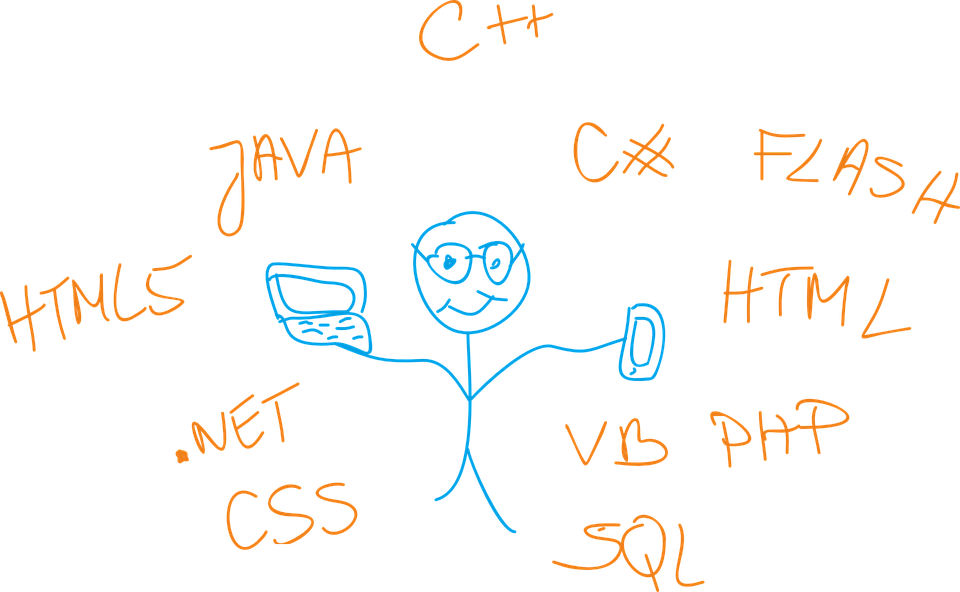Understanding the most popular programming languages of 2025 can help guide career decisions. In 2025, technology is advancing at an incredible rate, and programming languages are evolving to meet new demands. For anyone starting or looking to upgrade their skills in tech with each language offering unique strengths, knowing the uses, pros, and cons of each can provide a clearer path in software development, web development, data science, and beyond.
Below, we explore the top programming languages of 2025 and highlight their applications, strengths, and potential career benefits.
Why Learning Popular Programming Languages is Important

Choosing the right Popular Programming Languages can significantly affect career prospects, potential earnings, and development productivity. As technology evolves, so do industry requirements. This list will help developers, students, and professionals understand which languages are best for specific fields like web development, data science, machine learning, and more.
The Top Popular Programming Languages of 2025
Python: The All-Rounder Language
Python continues to be one of the most widely used Popular Programming Languages in 2025, and its popularity is only expected to grow. Known for its simplicity and readability, Python is ideal for both beginners and experienced developers.
- Key Uses: Data science, machine learning, web development, automation, and scripting.
- Pros: Easy syntax, strong community support, extensive libraries.
- Cons: Slower in execution compared to compiled languages like C++.
- Career Opportunities: Data Scientist, Machine Learning Engineer, Software Developer.
Python’s extensive library support, especially in data science (NumPy, pandas, and TensorFlow), makes it invaluable for AI and machine learning roles. For those interested, more details about Python’s applications can be found on Python.org.
JavaScript: The Language of the Web
JavaScript remains a top choice in 2025, especially for front-end development. It’s the foundation of dynamic, interactive web pages and is increasingly popular in back-end development with frameworks like Node.js.
- Key Uses: Web development, mobile app development, server-side scripting.
- Pros: Wide compatibility with browsers, versatility, and a huge ecosystem of libraries and frameworks (React, Angular, Vue).
- Cons: Less secure compared to some languages, browser dependency can sometimes complicate development.
- Career Opportunities: Front-End Developer, Full-Stack Developer, Mobile Developer.
JavaScript is a must for web developers, and those aiming for full-stack roles should consider mastering it alongside HTML and CSS. More resources on JavaScript are available on the Mozilla Developer Network (MDN).
Java: The Enterprise Backbone
Java has been a staple in enterprise environments for decades, and its reliability and performance make it a top choice for large-scale applications in 2025.
- Key Uses: Enterprise applications, Android app development, big data processing.
- Pros: Platform independence with JVM, robust security, great performance.
- Cons: Verbose syntax, slower development speed.
- Career Opportunities: Android Developer, Backend Developer, Enterprise Solutions Architect.
The JVM (Java Virtual Machine) enables Java to run on almost any platform, which is why it’s favored in corporate environments and Android development. For more details, check out Oracle’s Java Documentation.
C++: The Power of Performance
C++ remains relevant in 2025 for applications that demand high performance, such as game development, real-time simulations, and systems programming.
- Key Uses: Game development, high-performance applications, operating systems.
- Pros: High performance, control over memory, widely used in system-level programming.
- Cons: Complex syntax, steep learning curve.
- Career Opportunities: Game Developer, System Programmer, Embedded Systems Engineer.
C++ is known for its speed and memory management, making it ideal for high-performance tasks. To learn more about C++, visit cplusplus.com.
TypeScript: JavaScript for Large-Scale Projects
TypeScript, a superset of JavaScript, has gained traction for managing larger, complex web applications. Its strong typing helps developers catch errors early in development, making it a preferred choice in 2025 for scalable projects.
- Key Uses: Web development, especially in frameworks like Angular.
- Pros: Type safety, better tooling, easily integrates with JavaScript.
- Cons: Learning curve for JavaScript developers, larger code size.
- Career Opportunities: Web Developer, Full-Stack Developer, Front-End Engineer.
TypeScript has become popular in large-scale web applications due to its error-catching capabilities and the ability to be compiled down to JavaScript. More about TypeScript can be found on TypeScript’s official page.
Kotlin: The Modern Language for Android
Since Google officially endorsed Kotlin as the preferred language for Android, its popularity has skyrocketed. In 2025, Kotlin will be the go-to language for Android app development.
- Key Uses: Android development, web development, server-side programming.
- Pros: Concise syntax, interoperability with Java, great for Android apps.
- Cons: Smaller community compared to Java, limited resources.
- Career Opportunities: Android Developer, Mobile App Developer, Full-Stack Developer.
For Android development, Kotlin’s seamless integration with Java and concise syntax make it efficient. To dive deeper, see Kotlin’s official documentation.
Rust: For Safe and Efficient Systems Programming
Rust is gaining traction in 2025 for system-level programming, favored for its focus on memory safety and performance without a garbage collector.
- Key Uses: Systems programming, game development, web assembly.
- Pros: Memory safety, performance, growing community.
- Cons: Steep learning curve, limited library support.
- Career Opportunities: System Developer, Security Engineer, Game Developer.
Rust is an excellent choice for those interested in low-level programming without compromising safety. More information can be found at Rust’s official website.
Swift: Apple’s Language of Choice
Swift will remain the primary language for iOS and macOS applications in 2025. Developed by Apple, Swift is designed to be fast and powerful.
- Key Uses: iOS and macOS development.
- Pros: Fast performance, readable syntax, modern features.
- Cons: Limited to Apple platforms, a smaller community outside Apple’s ecosystem.
- Career Opportunities: iOS Developer, macOS Developer, Mobile Application Developer.
Swift’s design makes it a great popular Programming language for developers invested in Apple’s ecosystem. To explore more, check out Apple’s Swift documentation.
Emerging Popular Programming Languages to Watch in 2025

Go (Golang): For Scalable Backend Solutions
Go, developed by Google, will be increasingly popular for backend services, microservices, and distributed systems in 2025.
- Key Uses: Cloud services, microservices, backend development.
- Pros: Concurrency support, easy syntax, fast compilation.
- Cons: Limited to backend applications, fewer libraries compared to older languages.
- Career Opportunities: Backend Developer, DevOps Engineer, Cloud Engineer.
Go’s simplicity and concurrency model make it ideal for cloud-native applications. Find more at Golang’s official page.
Dart: Building Cross-Platform Mobile Apps
Dart, powered by the Flutter framework, is seeing a rise in popularity for cross-platform mobile app development in 2025.
- Key Uses: Mobile app development, especially with Flutter.
- Pros: Cross-platform compatibility, and fast development cycles.
- Cons: Limited backend functionality, smaller community.
- Career Opportunities: Mobile App Developer, Full-Stack Developer.
Dart is becoming a popular choice for developers aiming to reach both iOS and Android users with a single codebase. Check out more about Dart on Dart. dev.
How to Choose the Right Popular Programming Languages for Your Career in 2025
With so many options, choosing the best language depends on personal career goals, the type of projects one is interested in, and the industry. Here’s a breakdown:
- For Web Development: JavaScript, TypeScript, and Python are key languages to learn.
- For Mobile App Development: Swift for iOS, Kotlin for Android, and Dart for cross-platform.
- For Data Science & AI: Python is a primary language, with R also popular for statistical computing.
- For Systems Programming: C++ and Rust are recommended for performance and memory management.
- For Backend Development: Java, Python, and Go are solid choices.
Conclusion: Investing in the Future of Programming in 2025
The field of programming is dynamic, with languages continuously adapting to meet new technological needs. By understanding the most popular programming languages of 2025, developers can make informed choices, align their skills with market demands, and enjoy a rewarding tech career.
Whether your interest lies in data science, web development, or mobile applications, there is a language that will empower you to achieve your goals. With a solid foundation in one or more of these popular languages, you’ll be well-prepared for success in the ever-evolving tech landscape. For more information please get in touch
Frequently Asked Questions
Which programming language is the most popular in 2025?
Python remains the most popular language, especially for data science, machine learning, and general-purpose programming.
Is JavaScript still relevant in 2025?
Yes, JavaScript continues to dominate web development and is essential for both front-end and full-stack roles.
What language should I learn for mobile app development in 2025?
Swift is ideal for iOS development, Kotlin for Android, and Dart with Flutter for cross-platform applications.
Is Rust worth learning in 2025?
Rust is valuable for systems programming and applications requiring memory safety, especially if you’re interested in game or security-focused development.
Is Go a good choice for backend development?
Yes, Go is excellent for backend and microservices, especially in cloud-based environments.
Which languages are best for data science in 2025?
Python remains the top choice, supported by extensive libraries for data processing, visualization, and machine learning.